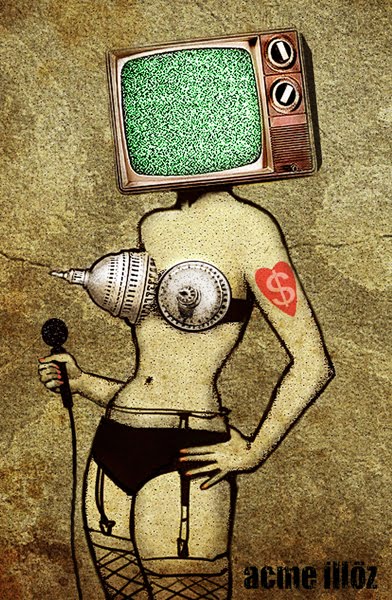 |
| ‘Presstitute: Anthony Freda Art |
Paul Craig Roberts, Contributor
Activist Post
Since mid-2009 the US has been enjoying a virtual recovery courtesy of a rigged inflation measure that understates inflation. The financial Presstitutes spoon out the government’s propaganda that prices are rising less than 2%. But anyone who purchases food, fuel, medical care or anything else knows that low inflation is no more real that Saddam Hussein’s weapons of mass destruction or Gadhafi’s alleged attacks on Libyan protesters or Iran’s nuclear weapons. Everything is a lie to serve the power-brokers.
During the Clinton administration, Republican economists pushed through a change in the way the CPI is measured in order to save money by depriving Social Security retirees of their cost-of-living adjustment. Previously, the CPI measured the change in the cost of a constant standard of living. The new measure assumes that consumers adjust to price increases by lowering their standard of living by substituting lower quality, lower priced items. If the price, for example, of New York strip steak goes up, consumers are assumed to substitute the lower quality round steak. In other words, the new measure of inflation keeps inflation down by reflecting a lowered standard of living.
Statistician John Williams (shadowstats.com), who closely follows the collecting and reporting of official US economic statistics, reports that consumer inflation, as measured by the 1990 official government methodology has been running at about 5%. If the 1980 official methodology for measuring the CPI is used, John Williams reports that the current rate of US inflation is about 9%. The 9% figure is more consistent with people’s experience in grocery stores.
Officially the recession that began in 2007 ended in June 2009 after 18 months, making the Bush Recession the longest recession since World War II. However, John Williams says that the recession has not ended. He says that only the GDP reporting, distorted by an erroneous measurement of inflation, shows a recovery. Other, more reliable measures of economic activity, show no recovery.
Williams reports that the economy began turning down in 2006, falling lower in 2008 and 2009, and bottom-bouncing ever since. Not only is there no sign of any recovery, but “the economic downturn now is intensifying once again.” The absence of an economic recovery “is evident in the [official] reporting of nearly all major economic series. Not one of these series shows a pattern of activity that confirms the recovery [shown] in the GDP series.”
Williams concludes that “the official recovery simply is a statistical illusion created by the government’s use of understated inflation in deflating the GDP.” In other words, the reported gains in GDP are accounted for by price increases, not increases in real output.
The result of the US government’s economic deception is the same as the deception Washington has used to start wars all over the Middle East. The government propaganda produces a make-believe virtual reality that bears no relationship to real reality. In history there have been many governments who have prevailed by deceiving the people, but Washington has moved this success to a new peak. As long as Americans believe anything Washington says, they are doomed.
It is easy to see why there is no economic recovery and cannot be an economic recovery. Look at the chart below (courtesy of John Williams, shadowstats.com).
Real median household income at the end of 2011 is back where it was in 1967-68. Moreover, Williams has deflated household income to get its real value by using the official inflation measure, which substantially understates inflation. If Williams had used the 1990 or 1980 official government methodology for calculating the consumer price index, the real median incomes of households would show a larger decline.
Moreover, the low 2011 real median household income is the summation, in most cases, of two household earners, whereas in 1967-68 one earner could produce the same real income. As Nobel economist Gary Becker, my former colleague as Business Week columnist, pointed out, when both husband and wife have to work in order to maintain the same purchasing power, household income from the wife’s in-kind household services is eliminated. Therefore, the monetary measure of the dual household income overstates income, because it is not adjusted for the lost benefits formerly provided by the wife who at home managed the household.
Americans are far more oppressed by the power brokers in Washington than statistics display. Moreover, the young are born into the oppressive, exploitative American system and do not know any different. They are fed by the Presstitute media with endless propaganda about how fortunate they are and how indispensable their wonderful country is. Americans are kept in a constant state of amusement, and many never grasp the loss of their civil liberties, job and career opportunities, and respect that the US won during the decades-long cold war with Soviet Communism.
On September 13, Federal Reserve Chairman Ben “Helicopter” Bernanke announced Quantitative Easing 3. Bernanke said that the recovery is weak and needs more Fed stimulus. He said the Fed will purchase $40 billion of mortgage bonds per month in order to drive interest rates further below the rate of inflation and help to sell more houses.
But how do you sell houses to households who are getting by with 1967-68 levels of real income and who have absolutely no job security? Their company can be taken over and offshored tomorrow or they can be replaced by foreign workers on H-1B visas. Housing prices have dropped, but not to 1967-68 levels.
Bernanke’s announcement that the Fed’s purchase of mortgage bonds is to spur housing and the economy is disinformation. Bernanke is purchasing the bonds in order to boost the values of the derivatives and debt instruments in the banks’ portfolios. Lower interest rates raise the value of the debt instruments on the banks’ balance sheets. By depriving American savers of a real interest rate on their savings, Bernanke makes the busted banks look solvent.
 |
| Introducing the NEW .999 fine one ounce |
This is what is happening in “freedom and democracy” America. The vast majority of Americans, especially the retired, are forced to consume their savings and draw down their capital because they can get no real interest on their savings. The beneficiaries are the banksters, who can borrow at near zero interest rates, charge consumers 16% on their credit cards, and use the Federal Reserve’s largess to speculate on interest rate swaps and credit default swaps. The American taxpayers hold the bag for the banksters’ uncovered gambles.
Would you not gamble if the American taxpayers had to cover your bets, but your winnings were yours alone?
The future of the American political order is in doubt. The Bush and Obama regimes have so badly abused the Constitution and statutory law, that the America that Ronald Reagan left to us no longer exists. America is on the path to collapse or tyranny.
Suppose that a miracle produces an economic recovery. What becomes of the enormous excess bank reserves that the Federal Reserve has provided the banks?
If these bank reserves are used for expanding loans, the money supply will outstrip the production of goods and services, and inflation will rise.
If the Fed tries to take the excess reserves out of the banking system by selling bonds, interest rates will rise, thus destroying the wealth of bond holders and draining liquidity from the stock market. In other words, another depression that wipes out the remaining American wealth.
The Federal Reserve’s announcement of QE3 shows that the Fed will continue to create new money in order to protect the values of the insolvent banks’ questionable assets. The Federal Reserve represents the banksters, not the American public. Like every other American government institution, the Federal Reserve is far removed from concerns about American citizens.
In my opinion, the Federal Reserve’s purchase of bonds in order to drive down interest rates has produced a bond market bubble that is larger than the real estate and derivative bubbles. Economically, it is nonsensical for a bond to carry a negative real interest rate, especially when the government issuing the bond is running large budget deficits that it seems unable to reduce and when the central bank is monetizing the debt.
The bubble has been protected by the euro “crisis,” which possibly is more of a virtual crisis than a real one. The euro crisis has caused money to seek refuge in dollars, thus supporting the dollar’s value even while the Federal Reserve prints money with which to purchase the never-ending flow of the governments’ bonds to finance trillion dollar plus annual budget deficits–about 5 times the “Reagan deficits” that Wall Street alleged would wreck the US economy.
Indeed, the US dollar’s exchange value is itself a bubble waiting to pop. The sharp rise in the dollar price of gold and silver since 2003 indicates a flight from the US dollar. (The chart is courtesy of John Williams, shadowstats.com.)
The bond market bubble will pop if the dollar bubble pops. The Federal Reserve can sustain the bond market bubble by purchasing bonds, and there are no limits on the Federal Reserve’s ability to purchase bonds. However, the endless monetization of debt, even if the new money is stuck in the banks and does not find its way into the economy, can spook foreign holders of dollar-denominated assets.
Foreign central banks can decide that they want to hold fewer dollars and more precious metals as their reserves. Other countries, sensing the US dollar’s demise, are organizing to conduct their trade without the use of the world’s reserve currency. Brazil, Russia, India, China, and South Africa intend to conduct their trade with one another in their own currencies. China and Japan have also negotiated to settle their trade balances with one another in their own currencies.
These agreements substantially reduce the use of the US dollar in international trade and, thus, the demand for dollars. When demand falls, so does price, unless the supply shrinks. But the Federal Reserve has announced, essentially, unlimited supply of US dollars. So we are faced with a paradox. The US dollar is supposed to remain valuable despite its enormous increase in supply.
In addition, China, America’s largest creditor and in the past a reliable purchaser of US Treasury bonds, holds some two trillion in dollar-denominated assets, primarily Treasury bonds. How is Washington treating its largest foreign creditor? Not with appreciation or deference. Washington is surrounding China with naval and air bases, interfering in China’s disputes with other countries, and bringing contrived actions against China in the World Trade Organization. Washington claims that US corporations are deserting the US not because of the lower cost of labor in China, but because of Chinese “subsidies” to the relocated US firms.
 In my April 30 column, “Brewing a Conflict with China,” I wrote that Washington would like to substitute a cold war with China for the hot wars in the Middle East. The problem with the hot wars is the loss of superpower face from Washington’s inability to prevail after eleven years, and although the hot wars are profitable for the military/security complex, the wars don’t generate the level of profits that would flow from a high-tech arms race with China. Moreover, Washington believes that diverting Chinese investment from the economy into a military buildup would slow the rate at which the Chinese economy is overtaking the US economy.
In my April 30 column, “Brewing a Conflict with China,” I wrote that Washington would like to substitute a cold war with China for the hot wars in the Middle East. The problem with the hot wars is the loss of superpower face from Washington’s inability to prevail after eleven years, and although the hot wars are profitable for the military/security complex, the wars don’t generate the level of profits that would flow from a high-tech arms race with China. Moreover, Washington believes that diverting Chinese investment from the economy into a military buildup would slow the rate at which the Chinese economy is overtaking the US economy.
What if instead of taking the bait from Washington, China targets Washington’s Achilles heel–the dollar’s role as reserve currency–and decides it is cheaper to dump one trillion dollars of US Treasury debt on the bond market than to commit to a 30 year arms race? To keep the price of Treasuries from collapsing, the Federal Reserve could print the money to buy the bonds. But if China then dumps the printed one trillion dollars in the foreign exchange markets, Washington cannot print euros, British pounds, Russian rubles, Swiss francs, and other currencies in order to buy up the dollars.
Frantic, Washington would try to arrange currency swaps with foreign countries in order to acquire the foreign exchange with which to buy up the dollars that, otherwise, will drive down the dollar exchange rate and destroy the Federal Reserve’s control over interest rates.
But if the Chinese don’t want the dollars, will other countries want to swap their currencies for the abandoned US dollar?
Some of Washington’s puppet states will comply, but the wider world will rejoice in the termination of Washington’s financial hegemony and refuse the offer.
Sooner or later the dollar will collapse from Washington’s abuse of the dollar’s role as reserve currency, and the dollar will lose its “safe haven” status. US inflation will rise, and US political stability, along with America’s hegemonic power, will wane.
The rest of the world will sigh with relief. And China will have defeated the superpower without an arms race or firing a shot.
This article first appeared at Paul Craig Roberts’ new website Institute For Political Economy. Paul Craig Roberts was Assistant Secretary of the Treasury for Economic Policy and associate editor of the Wall Street Journal. He was columnist for Business Week, Scripps Howard News Service, and Creators Syndicate. He has had many university appointments. His Internet columns have attracted a worldwide following. Donations to Paul Craig Roberts are much appreciated.




Be the first to comment on "The Virtual Recovery"